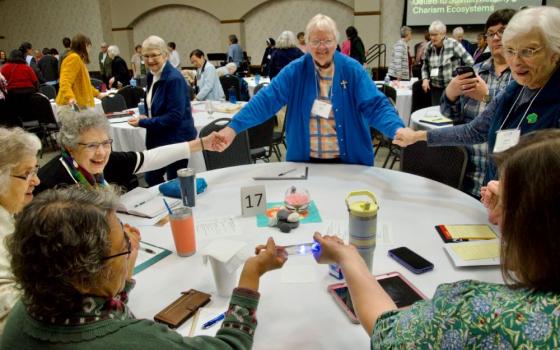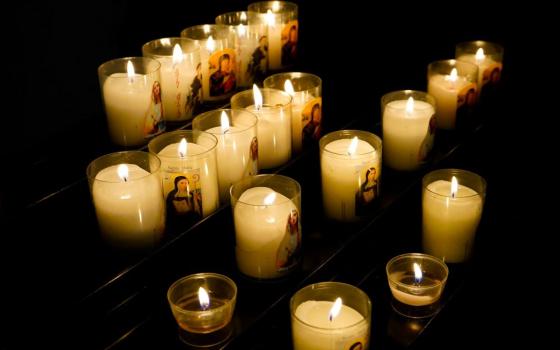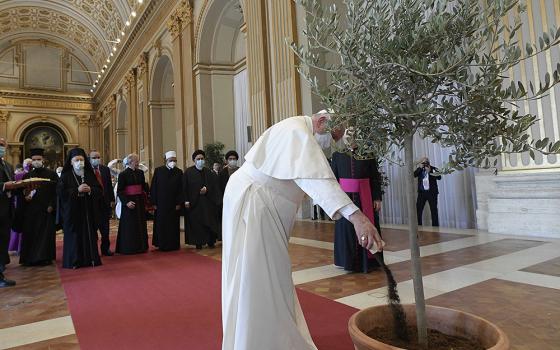
Sr. Mary Berigan, of the Sisters of Notre Dame, center, helps cut the ribbon on Blessing House's new facility April 30 in Lorain, Ohio, outside of Cleveland. (Courtesy of Blessing House)
Sr. Mary Berigan of the Sisters of Notre Dame was principal at a Catholic elementary school, and Donna Humphrey was a certified public accountant, but both volunteered as Court Appointed Special Advocates in the courts of Lorain County, Ohio, in the early 2000s.
Judges name Court Appointed Special Advocates in cases involving children, such as domestic violence and abuse and neglect cases, to argue for the best interests of the child. While an attorney may push for a child's legal rights, advocates look at the bigger picture in the child's life, such as family and education.
But even with advocates, children often fell through the cracks, Berigan and Humphrey found. They also saw that many times, what families needed was not the court system, but a little help.
So in 2005, after 25 years in Catholic education, Berigan opened Blessing House with Humphrey to provide temporary care for children and help for their families. Berigan is executive director, and Humphrey is director of development.
The nondenominational faith-based nonprofit was in a 3,000-square-foot home that worked fine for years. But gradually, the services Blessing House offered and the number of children in need continued to grow. The city of Lorain is about a half-hour west of Cleveland and is dominated by a sprawling steel mill that dwarfs the downtown. One in 4 people live below the federal poverty line, which for a family of four is $26,200.
After much planning and fundraising, a new 16,730-square-foot building was blessed and dedicated April 30. The final touches are being done, and they hope to move children in May 27. The capital campaign for the project is in its final stages, with about $250,000 left to raise of the $3.1 million total cost.
Advertisement
Berigan said that in the planning stages of construction, members of the staff gathered around a table where Berigan had put out children's toy blocks marked with labels for the agency's different functions, such as bedrooms, bathrooms, activity rooms and administrative spaces. The staff then arranged the blocks in the way they thought was best for the children who would be staying there to determine the layout for the building.
"I took a picture of it and gave it to our architect and said, 'This is what we want,' " Berigan said.
GSR: What exactly is Blessing House? Is it foster care? A shelter?
Berigan: It's a children's crisis care center. The placements are all voluntary, made by the parent or guardian, and they stay here until the family's issues are addressed. The issues aren't always resolved, but they're at least addressed. It's not foster care, and there is no charge to the parents or family.
"With the pandemic, we're seeing a lot of parents who have reached their limit of what they can deal with at any one time."
Sometimes, it's a situation in which the mom goes to the hospital and expects to be back in a few hours, so she leaves the kids with a neighbor. But then, Mom needs surgery, and the neighbor has her hands full with her own kids. Sometimes, moms go to court and think they're going to be home in a few hours, and they're not.
With the pandemic, we're seeing a lot of parents who have reached their limit of what they can deal with at any one time. Domestic violence went up during the pandemic, and it's still up. People are facing situations where they need to get away and be safe.
We make sure we're helping them with whatever their needs are. We make sure the kids are safe. That's the bottom line for us.
If there's no charge to the families, how is it all paid for?
We have a small line item in the state budget, which we're very grateful for and which we share with the other children's crisis care center in the state. The foundations in the area have been very supportive from the beginning. They recognize we're keeping children out of foster care.
We're nondenominational but faith-based, so we have the support of, gosh, every denomination under the sun. And there's lots of folks in the community who will take up collections and raise money to support us. It's just amazing. It's so awesome to see everybody stepping up for these kids.
One of our kids came back right after he graduated from high school. In his essay to get into college, he wrote about Blessing House. He said, "I know if we had not come to Blessing House, we would not still be a family."
Clients tend not to think of it as a social service agency, although we are that in the state of Ohio. They just think of it as Blessing House. We're just grateful for the fact we know that for so many of these kids, we intervened at a critical time in their lives.
So now that the new facility is almost done and almost paid for, what's next?
Because we have more space than we had before, we've already set up meetings with other agencies to see what we can partner on to provide more services to the kids and their families. For example, there's a need for a place for supervised visits for parents who should not be in the same room together. We're also looking at internships and occupational or physical therapy, which are needed. Now that the physical facilities are built, we're looking at what is lacking in the county in terms of services.
"We're just grateful for the fact we know that for so many of these kids, we intervened at a critical time in their lives."
Because of our partnerships, in a recent case, we were able to reach out to the domestic violence shelter; we were able to reach out to the police, which were needed in this situation; and we were able to reach out to the school the child was attending. The school reached out to an attorney that knows both facilities [the shelter and Blessing House] and had worked with both of us. Just to be able to wrap support around that family means so much.
These cases must be so stressful and emotional. How do you not take sides in a conflict?
It's about the kids and what's in the best interest of the children. Sometimes, you work with someone that you, on a personal level, would prefer not to. But we work with them to do whatever is best for the child. It can be a challenge at times, but as long as we keep our focus on the child, we're OK.
And that's where the services to the family come in. So many of these parents had childhoods where they really weren't parented. So we can give them some guidance or direction, like, "Here's how you might handle this" or "Here's some things you can do in this situation."
It's that bottom-line question: What is going to be best for the child?









